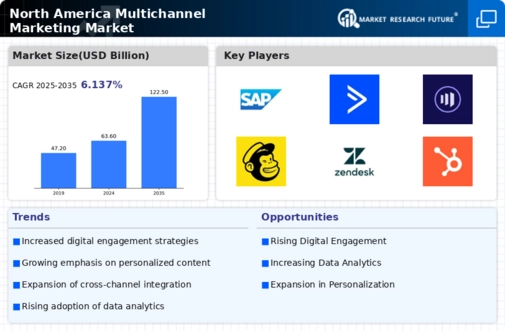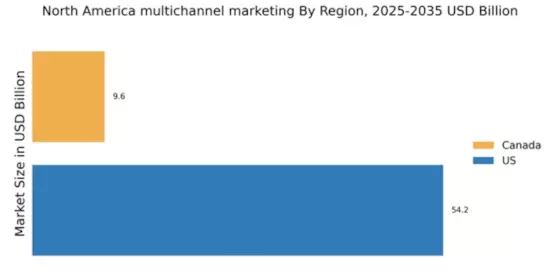Rising Consumer Expectations
The multichannel marketing in North America is experiencing a notable shift due to rising consumer expectations. Customers now demand seamless interactions across various platforms, which compels businesses to adopt more integrated marketing strategies. This trend is reflected in a survey indicating that 70% of consumers expect a consistent experience across channels. As a result, companies are investing heavily in multichannel marketing solutions to meet these expectations. The need for personalized communication and timely responses is driving the market, as businesses strive to enhance customer satisfaction and loyalty. This evolving landscape suggests that organizations must prioritize their multichannel marketing efforts to remain competitive and relevant in an increasingly demanding environment.
Growing Importance of Customer Experience
In the multichannel marketing in North America, the growing importance of customer experience is a critical driver. Companies are increasingly focusing on creating positive interactions across all touchpoints, recognizing that customer satisfaction directly impacts brand loyalty and revenue. Research shows that businesses prioritizing customer experience see a 60% increase in repeat purchases. This emphasis on customer-centric strategies is pushing organizations to refine their multichannel marketing efforts, ensuring that every customer interaction is meaningful and engaging. As the market evolves, companies that excel in delivering exceptional customer experiences are likely to gain a competitive edge.
Shift Towards Data-Driven Decision Making
The multichannel marketing in North America is increasingly characterized by a shift towards data-driven decision making. Businesses are recognizing the value of data analytics in shaping their marketing strategies, leading to more informed and effective campaigns. Recent studies indicate that organizations utilizing data-driven approaches experience a 20% increase in customer engagement. This trend is prompting companies to invest in advanced analytics tools and platforms that facilitate real-time data collection and analysis. As a result, marketers can better understand their target audiences and tailor their messaging accordingly, which is essential for success in the competitive landscape of multichannel marketing.
Technological Advancements in Marketing Tools
Technological advancements are significantly influencing the multichannel marketing in North America. The proliferation of sophisticated marketing tools and platforms enables businesses to analyze consumer behavior more effectively and tailor their strategies accordingly. For instance, the adoption of data analytics tools has increased by 45% in the last year, allowing marketers to gain insights into customer preferences and optimize their campaigns. Furthermore, the integration of automation technologies streamlines marketing processes, enhancing efficiency and effectiveness. As companies leverage these advancements, they are likely to see improved engagement rates and higher returns on investment, thereby driving growth in the multichannel marketing sector.
Increased Investment in Digital Marketing Channels
The multichannel marketing in North America is witnessing increased investment in digital marketing channels. As consumers increasingly engage with brands online, businesses are reallocating their marketing budgets to focus on digital platforms. Data indicates that spending on digital marketing is projected to grow by 25% over the next year, reflecting the shift in consumer behavior. This trend is driving companies to enhance their online presence and utilize various digital channels, such as social media, email, and search engines, to reach their target audiences effectively. As organizations adapt to this changing landscape, the multichannel marketing market is likely to expand, driven by the need for innovative and effective digital strategies.


















Leave a Comment